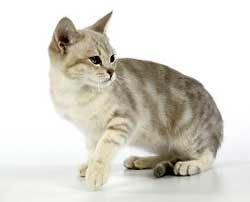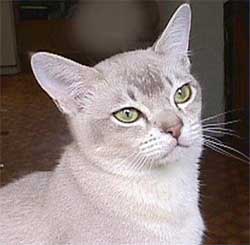Asians - Tabby
Asian Group Tabbies
(Breeds 72 38 – 72 38fnq; 72 41 – 72 41fnq; 72 44 – 72 44fnq; 72 45 – 72 45fnq; 72 38s – 72 38fnsq; 72 41s – 72 41fnsq; 72 44s – 72 44fnsq; 72 45s – 72 45fnsq)
Coat Pattern and Colour - The tabby pattern, which may be Spotted, Classic, Mackerel or Ticked, is formed by markings of the solid pattern colour on a background of agouti hairs. The pattern colour in Standard Tabbies should be that of the equivalent coloured Asian Selfs and Torties or their Burmese Colour Restriction counterparts. In Silver Tabbies the pattern colour may lack warmth and this should not be penalised. The pattern colour in Spotted, Classic and Mackerel Tabbies should match on head, body, legs and tail. There should be no speckling of agouti hairs in the markings and a pattern, which consists of dark agouti on a light agouti background, is incorrect and must be penalised. In Ticked Tabbies the pattern colour on head, legs and tail should match the ticking colour on the body.
In Standard Tabbies the markings should be dense, as near as possible to the roots and in Silver Tabbies they should extend well down the hair. The marking should show good contrast with the ground colour, but in dilute colours and Burmese restriction colours, the contrast between the markings and the ground colour is less than that required in non-dilute or full expression colours. In Tortie Tabbies the distribution of Tortie markings is immaterial.
1. The Burmese Colour Restriction Gene has the effect of reducing the melanin in the hair shaft particularly close to the skin, thus colour cannot be sound to the roots nor can the undercoat be as rich as in the equivalent full expression cat. However, in all Asian Tabbies of Burmese Colour Restriction the markings should be as near to the roots as possible and show good contrast with the ground colour. The ears and mask of Burmese colour restriction cats may be slightly darker.
2. In Silver Tabbies tarnishing i.e. discoloration of the silver ground colour is undesirable.
3. In full expression colour Asian Tabbies the markings should show good contrast with the ground colour.
Download a checklist for the Asian Group Tabby pattern here
Head Markings - On the forehead there should be an "M". In Ticked Tabby kittens there may be a skullcap, which may clear to an "M" in adults. There should be an unbroken line running from the outer corner of each eye and pencilling on the cheeks. The edges of the ears should be the same colour as the markings with a central patch of ground colour resembling a thumbprint. The Tabby has a tendency to white in the immediate area of the lips and lower jaw. It is a serious fault if this extends to the throat in standard tabbies.
Leg Markings - The legs of the Ticked Tabby may or may not be barred. However, the legs of the Mackerel and Spotted should be barred and/or spotted. The legs of the Classic Tabby should be barred. In all patterns the darker pattern colour should extend from the feet up the back of the leg to the hock joint.
Tail Markings - The markings on the tail of all Asian Tabbies may range from complete (all patterns) or broken rings (Ticked, Mackerel and Spotted pattern) to a continuation of the darker colour on the spine line (Ticked pattern). The tail should have a solid tip of the darker colour except in Red, Cream, Apricot and Tortie Tabbies where a light tip is permitted.
Body Markings
Spotted Pattern (--38) - The coat should have all markings clearly defined. The spots may vary in size but should be round and evenly distributed. The spots should not run together in any part of the coat. Lines should extend from the top of the head down the back of the neck, breaking into spots on the shoulder and along the spine. The legs should be barred and/or spotted. The denser concentration of colour should extend from the feet up the back of the leg to the hock joint. On the neck and upper chest there will be necklaces, which may be broken, the more the better. The belly should be spotted. The tail should be marked with complete or broken rings.
Classic Pattern (--41) - The coat should have all markings clearly defined. The ground colour and markings should be equally balanced overall. There should be a vertical line or lines running over the back of the head and extending to the shoulder markings, which should be shaped like a butterfly seen from above. Both the upper and lower "wings" should be clearly defined in outline, with dots inside the outline. On the back there should be an unbroken line running down the spine from the butterfly to the tail, with a stripe on either side of this line running parallel to it. The stripes should be separated from it by stripes of ground colour. On each flank there should be a large oyster or blotch surrounded by one or more unbroken rings. Both sides of the cat should have symmetrical identical markings. On the neck and upper chest there should be unbroken necklaces, the more the better. The belly may be spotted, blotched or barred. The tail should be banded.
Mackerel Pattern (--44) - The coat should have all markings clearly defined. There should be a narrow unbroken line running from the back of the head to the base of the tail, on either side of which should be a broken spine line from which narrow vertical lines run down the body. These lines should be as narrow and as numerous as possible and should be unbroken. On the neck and upper chest there should be necklaces, which may be broken, the more the better. The belly should be spotted or barred. The tail rings should be as narrow and numerous as possible, complete or broken.
Ticked Pattern (--45) - The coat should be evenly ticked with two or three bands of the pattern colour extending well down each hair shaft. The darker colour should be more apparent down the spine line, shading to the paler ground colour on the belly and inside the legs. Any necklaces may be broken or unbroken. The belly may be spotted. The legs may be barred. The tail may be ringed with complete or broken rings or may have a continuation of the darker colour of the spine line.
Scale of Points for all Tabby Patterns - as in Asian General Type Standard.
Withhold Certificates or First Prizes in Kitten Open Classes for:
1. General Asian withholding faults
2. Incorrect tabby pattern, colour or ground colour
3. Lack of contrast between pattern and agouti or silver ground colour
4. Unbroken spine line in adults (Spotted Tabbies only)
5. Light tip to tail except in Red, Cream, Apricot or Tortie Tabbies
6. White on lower jaw extending down the neck (except in Silver Tabbies)
Faults:
1. Tarnishing on silver.
2. Cold grey tone to agouti ground colour.
Colour Descriptions for all non-Silver (Standard) tabby patterns:
Black (Full Expression Colour) - Jet-black markings on a warm-toned coppery brown ground.
Brown (Burmese Colour Restriction) - Rich, warm seal brown markings on a creamy beige ground.
Blue (Full Expression Colour) - Medium to dark pewter blue markings on [delete: cool-toned] an oatmeal or mushroom beige ground.
Blue (Burmese Colour Restriction) – Light to medium blue grey markings on a cool-toned very pale beige ground.
Chocolate (Full Expression Colour) - Rich warm even chestnut brown markings on a warm-toned bronze ground.
Chocolate (Burmese Colour Restriction) - Warm milk chocolate markings on a warm beige ground.
Lilac (Full Expression Colour) – Medium to dark even dove grey on a cool-toned beige ground.
Lilac (Burmese Colour Restriction) - Pale dusky dove grey markings on a cool toned pale beige ground.
Red (Full Expression Colour) - Rich intense dark tangerine markings on a bright paler tangerine ground.
Red (Burmese Colour Restriction) - Light tangerine markings on a ground of warm very pale tangerine.
Cream (Full Expression Colour) – Even medium cool toned cream markings on a ground of paler cream.
Cream (Burmese Colour Restriction) – Delicate even pale cool-toned cream markings on a ground of very pale cream, having a powdered effect.
Caramel (Full Expression Colour) – Either medium to dark brownish grey showing a purplish cast marking on a paler cool-toned beige ground or paler brownish grey markings showing rich honey overtones on a ground of paler cool-toned beige. All caramels should display a metallic sheen especially on the head, up the hocks and around the paw pads; this may be less evident in kittens.
Caramel (Burmese Colour Restriction) - Cool toned brownish grey markings graduating to a rich honey colour on a ground of very pale cool-toned beige. All caramels should display a metallic sheen especially on the head, up the hocks and around the paw pads, but this may be less evident in kittens.
Apricot (Full Expression Colour) - Hot intense pinkish cream markings on a ground of pale cream; a soft metallic sheen which becomes more noticeable with maturity, especially on the head, up the hocks and around the paw pads.
Apricot (Burmese Colour Restriction) – Warm intense pinkish cream markings on a ground of very pale cream; a soft metallic sheen which becomes more noticeable with maturity, especially on the head, up the hocks and around the paw pads.
Cinnamon (Full Expression Colour) – Rich, warm-toned medium cinnamon brown markings on a warm light cinnamon brown ground.
Cinnamon (Burmese Colour Restriction) – Warm light cinnamon brown markings on a warm very pale cinnamon brown ground.
Fawn (Full Expression Colour) – Warm rosy mushroom (the pinker the best) over warm pale mushroom ground.
Fawn (Burmese Colour Restriction) – Very pale pearly fawn markings on a very pale mushroom ground.
All Tortie Tabbies: Markings in a mix of the relevant two Tortie colours on appropriate ground colours as specified above.
All Silver Tabbies: Coat colour and markings as above on a silver agouti ground which shows a hint of the tone of the main coat colour. Silver white colour on the throat and muzzle of silver tabbies is not a fault. Tarnishing is undesirable.



.jpg)
